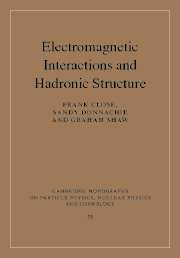Book contents
- Frontmatter
- Contents
- List of contributors
- Preface
- 1 Quark models of hadrons and issues in quark dynamics
- 2 Elastic form factors
- 3 Electromagnetic excitations of nucleon resonances
- 4 Meson radiative decays
- 5 Intermediate-energy photoproduction
- 6 Chiral perturbation theory
- 7 Spin structure functions
- 8 Diffraction and colour dipoles
- 9 Generalized parton distributions
- 10 Quark–hadron duality
- 11 Colour transparency
- Index
6 - Chiral perturbation theory
Published online by Cambridge University Press: 15 August 2009
- Frontmatter
- Contents
- List of contributors
- Preface
- 1 Quark models of hadrons and issues in quark dynamics
- 2 Elastic form factors
- 3 Electromagnetic excitations of nucleon resonances
- 4 Meson radiative decays
- 5 Intermediate-energy photoproduction
- 6 Chiral perturbation theory
- 7 Spin structure functions
- 8 Diffraction and colour dipoles
- 9 Generalized parton distributions
- 10 Quark–hadron duality
- 11 Colour transparency
- Index
Summary
In the Standard Model the up and down quarks – the constituents of normal matter – couple very weakly to the electroweak Higgs field. The resulting ‘current’ masses for these quarks are of the order of 10 MeV. This is much smaller than the typical energies of hadronic states (several hundred MeV or more). In the context of low-energy QCD, this means that these quarks are nearly massless and so, to a good approximation, their chiralities are preserved as they interact with vector fields (gluons, photons, Ws and Zs). This conservation of chirality has important consequences for hadronic physics at low energies.
If chirality is conserved, then right- and left-handed quarks are independent and we have two copies of the isospin symmetry which relates up and down quarks. The QCD Lagrangian therefore is symmetric under the chiral symmetry group, SU(2)R x SU(2)L. However, the hadron spectrum shows no sign of this larger version of isospin symmetry; in particular, particles do not come in doublets with opposite parities. Moreover, constituent quarks, as the building blocks of hadrons, appear to have masses that are much larger than their current masses.
This conundrum can be resolved if the chiral symmetry of the theory is hidden (or spontaneously broken) in the QCD vacuum. A non-vanishing condensate of quark- antiquark pairs is present in the vacuum, and this is not invariant under SU(2)R SU(2)L transformations. The energy spectrum of quarks propagating in this vacuum has a gap (like that for electrons in a superconductor), implying that masses have been dynamically generated.
- Type
- Chapter
- Information
- Electromagnetic Interactions and Hadronic Structure , pp. 229 - 270Publisher: Cambridge University PressPrint publication year: 2007
- 1
- Cited by

